Where To Stay In Florence: A Guide for First Timers
We have both been to Florence multiple times, and on a relatively recent trip to Italy, we were debating whether to even make a stop in Florence. In Alysha’s opinion (at the time), Florence is overrated because it’s just inundated with tourists, particularly in the peak summer months.
However, I (Matt) am proud to say that after advocating for visiting Florence and staying for the better part of a week, she had come around to seeing the value that Florence offers.
It’s a beautiful city, with tons of history (the Medici family in real life is way better drama than Game of Thrones ever came up with), a huge impact on the history of art, and some great food to be had thanks to the bounty of ingredients coming from Tuscany, the region of Italy that Florence is the capital of.
In this guide, we’re going to use our experiences exploring Florence to do our best to walk you through all the information you need to figure out where to stay in Florence for your particular style, budget, and preferences.
We’ve both been to Florence multiple times over the past couple of years, including a longer stay a few years ago that had Alysha reconsidering her stance that Florence is overrated.
Each neighborhood that we’re going to cover below offers a different blend of vibes, prices, and pros and cons, and we’ll cover it all so that you’re armed with all the information you need to figure out the best place to stay for your particular style and budget.
Our intention is that, by the end of this guide, you have everything you need to choose the right place to stay for you and your travel companions.
Sound good to you? Let’s get into it.
Important note: This is a long guide with lots of detail (it got longer and longer as we put it together), but we’ve done our best to structure it with headings, a helpful summary at the top, and a table of contents to help you navigate it without reading literally every word.
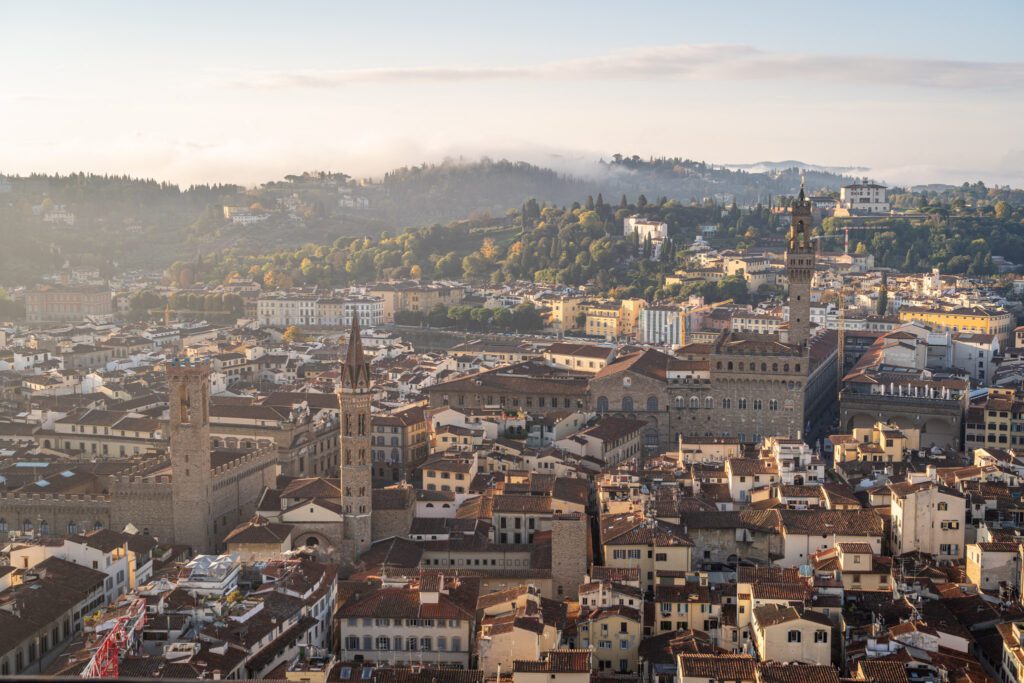
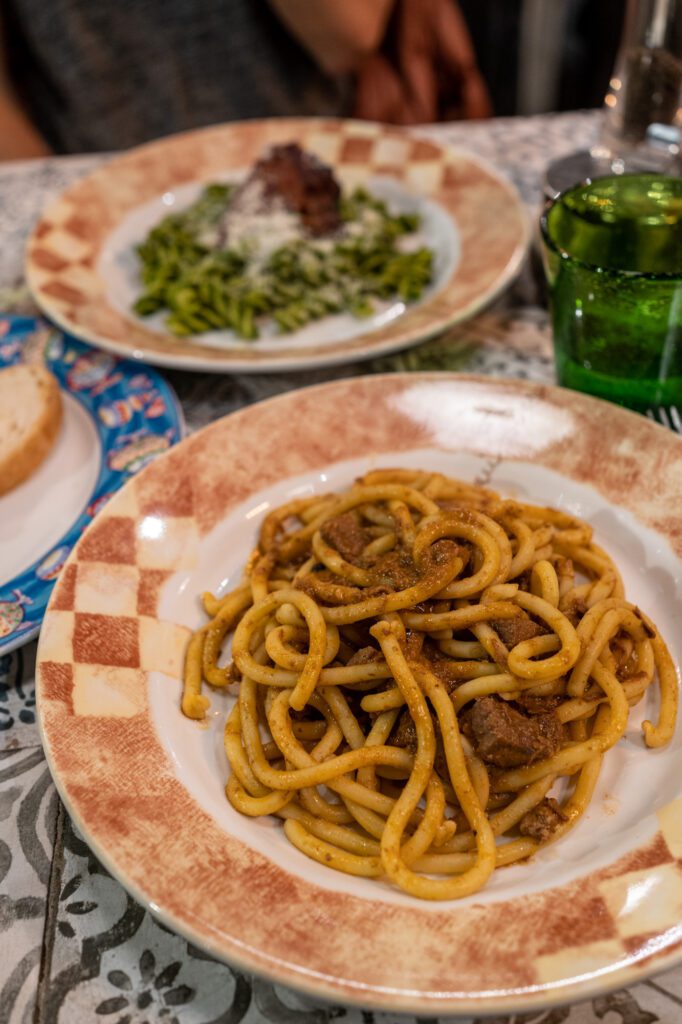

Disclaimer: Some of the links in this post, like hotel links, are affiliate links, meaning at no additional cost to you, we make a little bit of money if you click through and book. That being said, we would never recommend something to you that we don’t stand behind 100%.
Where to Stay in Florence: The 5 Best Places to Stay
For this guide, we’re going to jump right into it, because we’ve got a lot of ground to cover.
Our philosophy when it comes to deciding on a place to stay is to first choose the neighborhood, then move on to finding a great hotel, hostel, or apartment in that area.
The reality is that, depending on what you’re looking for, there are other neighborhoods not included in this guide that might meet your needs. But these are the ones that we think are the best for 99% of travelers, and we’ve shown our work, doing our best to explain why we think that.
In general terms, we think that the best places to stay are located within a short walk of the Centro Storico, which is where you’ll find the Duomo and Piazza della Signoria.
However, Florence’s historic center is absolute madness during peak hours in the spring, summer, and fall. So we’ve also got a few places that we’ll cover below that will offer a less hectic, slightly more residential feeling, which is generally what we prefer when we’re traveling.
For each of the neighborhoods below, we’ve created a structure to help you figure out if it’s the right home base for you. Here’s what we’ll cover:
- An overview of the neighborhood and our experience with it. We’ve personally been to and explored (more than once) all of the areas on this list, so we’ll try to give you a little bit of our perspective on what makes each area special.
- Pros and cons of staying in this area. The things you need to know to make your decision.
- Highlights of the neighborhood. Coffee shops, restaurants, parks, etc that we enjoyed, and think you probably will too.
- A collection of a few places to stay that stood out to us. Sometimes it’ll be because they have rooms with Duomo views, sometimes it’s the rooftop pool, sometimes it’s that the hotel offers a great value given the location.
Now, we’re well aware that a few of you are currently ready to throw your left shoe at the screen, saying “I don’t have time to read all of that, JUST TELL ME THE BEST PLACE TO STAY!”
Well, here’s a quick summary of this guide if you’re short on time (though we’d recommend reading the section of the place you end up staying for tips and places to add to your list!).
- If you’re looking to stay in the coolest neighborhood (also our favorite) in Florence stay in Santa Croce. Just outside your front door, you’ll find plenty of places to eat and drink. Plus, this is where Michelangelo grew up (and, later, he was buried at the Basilica di Santa Croce). We stayed at Pietrapiana Boutique Apartments to have access to a kitchen on our last trip and loved it. For a more traditional hotel, stay at La Maison du Sage (which is right on Piazza di Santa Croce!).
- If it’s your first time in Florence, you can’t go wrong with the Centro Storico. The part of the historic center between the Duomo and Piazza della Signoria is charming, central, and a lovely home base for exploring the rest of the city. The tradeoff is, you guessed it, price – it’s the most expensive part of the city, but you’re paying for the location and vibe of being in the heart of all the action, present and historical. We like the look of the Artists’ Palace (a good value just a long block away from the Duomo) and also Hotel Milù (a highly rated, beautiful boutique hotel in a relatively quiet part of the center).
- If you’re looking for something a little more low-key where people actually live, look at Oltrarno. This is the neighborhood on the south side of the Arno River from the historic center, and as soon as you cross the bridge you’ll notice the vibe shift. There’s more Italian being spoken (it’s still the center of Florence, so you’ll hear plenty of other languages too) and there are some truly excellent places to eat and drink. The problem is that there aren’t that many places to stay here. If we were you, we’d run – don’t walk – to book one of the five rooms at FuordArno Bed & Breakfast, which is BY FAR our top pick in the neighborhood.
- If you’re on a budget and looking for a good value, San Marco is a good option. Staying here means cheaper rooms that require a little extra travel time to get from place to place (the neighborhood itself doesn’t offer much in terms of attractions or things to do, except for the Galleria dell’Accademia di Firenze where you’ll find the David). It’s more residential and still a nice place to stay if you’re willing to make the tradeoff between price and location. Stay at Room Mate Luca if you’re looking for a beautiful, modern boutique hotel, or IQ Hotel Firenze if you’re looking for a great value (we’ve stayed at their hotel in Milan, and it was a good night’s sleep for a reasonable price, which we love).
Santa Croce: Our #1 Recommendation (Where We’ve Stayed)
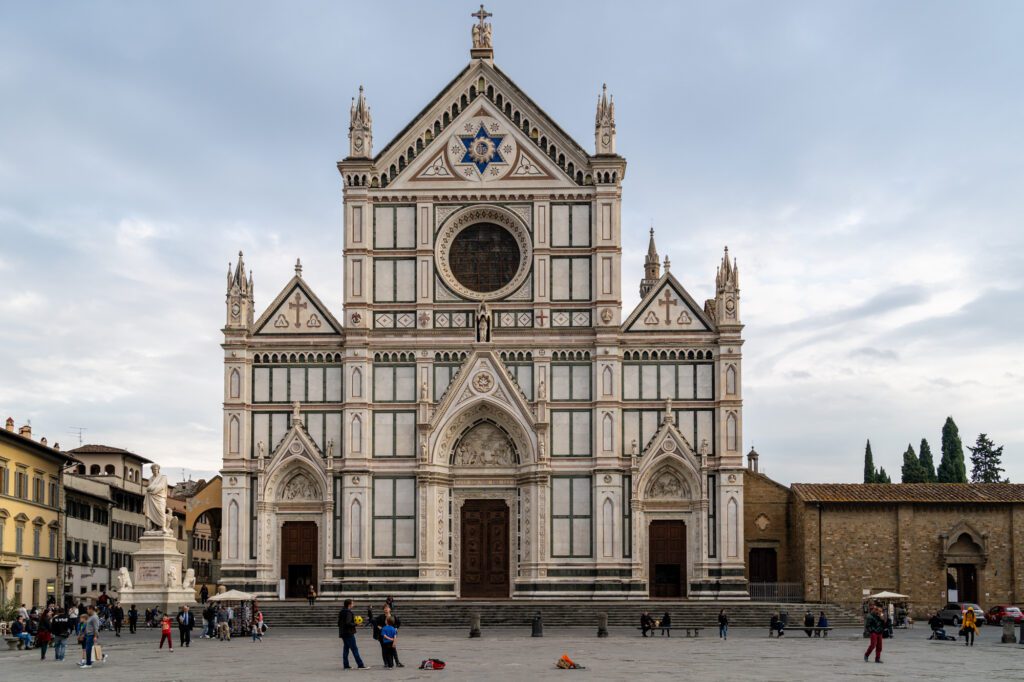
Santa Croce, which is where we like to stay in Florence, is just east of the Duomo (so slightly outside of the busiest part of central Florence) and offers a nice combination of walkability and places to eat and drink.
The neighborhood is centered around Piazza di Santa Croce and the Basilica di Santa Croce di Firenze with its multi-colored facade, and stretches south to the Arno River and north up to Mercato Sant’Ambrogio. Generally speaking, the further east you go in Santa Croce, the fewer tourists you’ll see.
There are a few reasons we like this part of Florence.
One, we’re big walkers (we often get 25,000 or 30,000 steps in a day when we’re traveling) and from here, you’ll be able to walk basically everywhere in Florence (though the train station is a longer walk). It’s 5-10 minutes to the Duomo and Piazza della Signoria, and just a little longer to the Arno River and the many bridges crossing it.
Two, there are tons of good places to eat and drink in this part of the city (particularly for gluten free travelers – here’s our guide to eating gluten free in Florence).
Mercato Sant’Ambrogio is a good choice if you want to sample a bunch of different things, and a few of our favorite coffee shops in Florence are within this neighborhood’s rough boundaries.
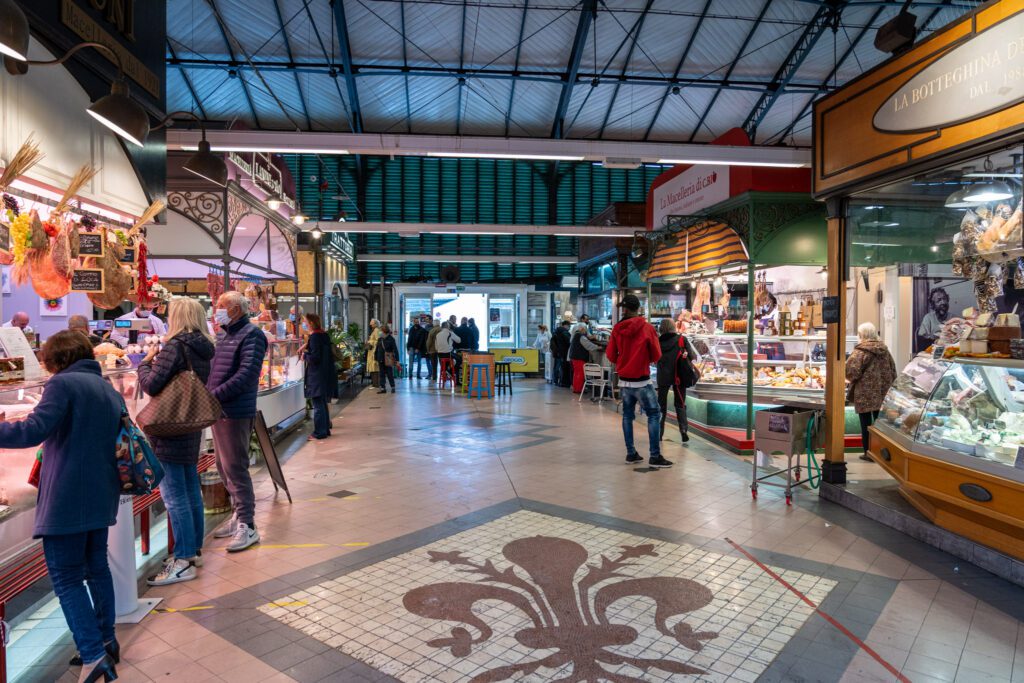
Pros and Cons of Staying in Santa Croce
Here are the pros and cons of staying in Santa Croce as we see them.
Pros of Staying in Santa Croce
- It’s (slightly) less crowded. Being just outside of the historic center, you can expect to find fewer tourists around. However, it’s worth remembering that it is still the center of Florence, so there are absolutely still tourists. It’s just that there are going to be fewer of the wall-to-wall streets packed with tourists just there for the day.
- It’s in a central location. Santa Croce is only a 5-10 minute walk to many of the main landmarks of the city center, including Piazza della Signoria (and the Uffizi Gallery) and the Duomo.
- It has a great nightlife scene. Santa Croce is well-known for its vibrant nightlife, and is particularly popular with the city’s student population. Heading out for some drinks here is a must, and the party is often still going into the early morning hours (which you’ll also find below in the cons section).
- It’s basically heaven for foodies. Mercato Sant’Ambrogio and the area surrounding it is the place to go for some of the best affordable local restaurants and cafes in Florence.
Cons of Staying in Santa Croce
- It can be noisy at night. With its many restaurants, late-night bars, and live music venues, the area can remain noisy late into the evening and night. We experienced this when we stayed here and walked back to our apartment around midnight only to find the streets PACKED with young people out drinking (and the related carnage walking the same route the next morning).
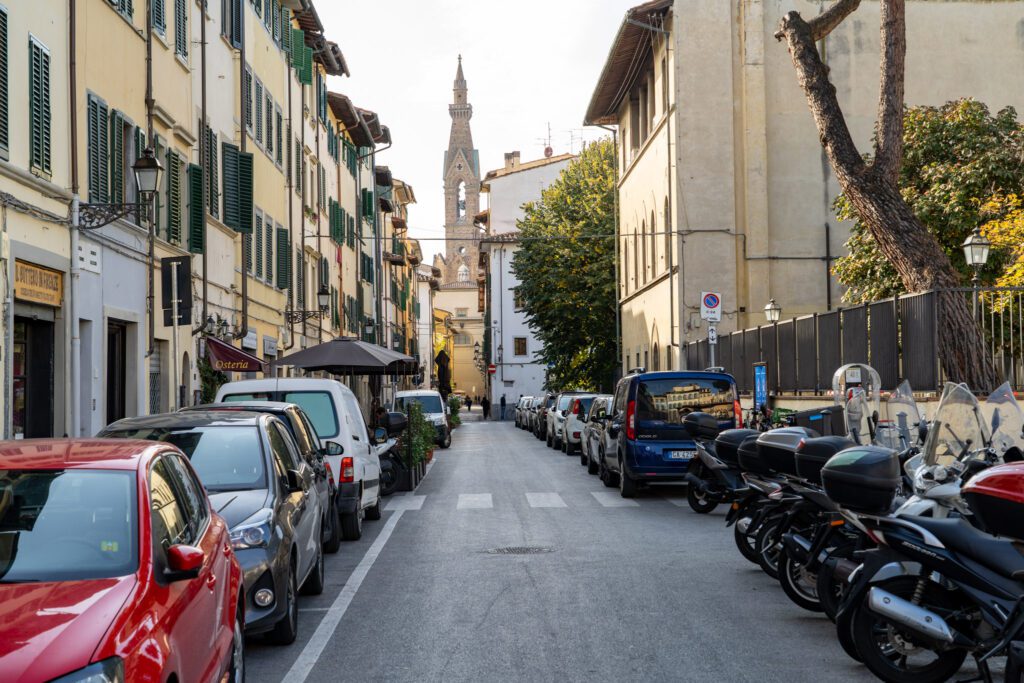
Santa Croce Highlights
Here are some of our favorite places in Santa Croce, in no particular order.
- Sant’Ambrogio Market is a historic indoor market selling meats, cheeses, fresh produce, and more. The lively market is popular with locals and is a unique glimpse into Florentine life. Don’t forget to try some tasty Tuscan specialties at the market’s Trattoria Da Rocco. We picked up some cheese and cured meats for a picnic at our apartment, and really, really liked the pecorino piccante (with spicy peppers) that we got at this market!
- The Basilica of Santa Croce dates all the way back to the 1200s and is the largest Franciscan church in the world. The important basilica is filled with amazing frescoes by Giotto and Gaddi. It is also the final resting place of many notable Italians, including artist Michelangelo, scientist Galileo Galilei, and political philosopher Niccolò Machiavelli.
- Gelateria Vivoli can be found close to the Basilica of Santa Croce and serves some of the best gelato in all of Florence.
- Ditta Artigianale and Coffee Mantra are a couple of our favorite places to stop for a coffee in the area. Read our guide to the best coffee in Florence for more great spots to find good coffee.
- Enoteca Alla Sosta Dei Papi is a great spot to grab a glass of wine (heavy pours!), with wines by the glass of all different varietals focusing mainly on wines from Tuscany. Truly one of the best values in Florence.
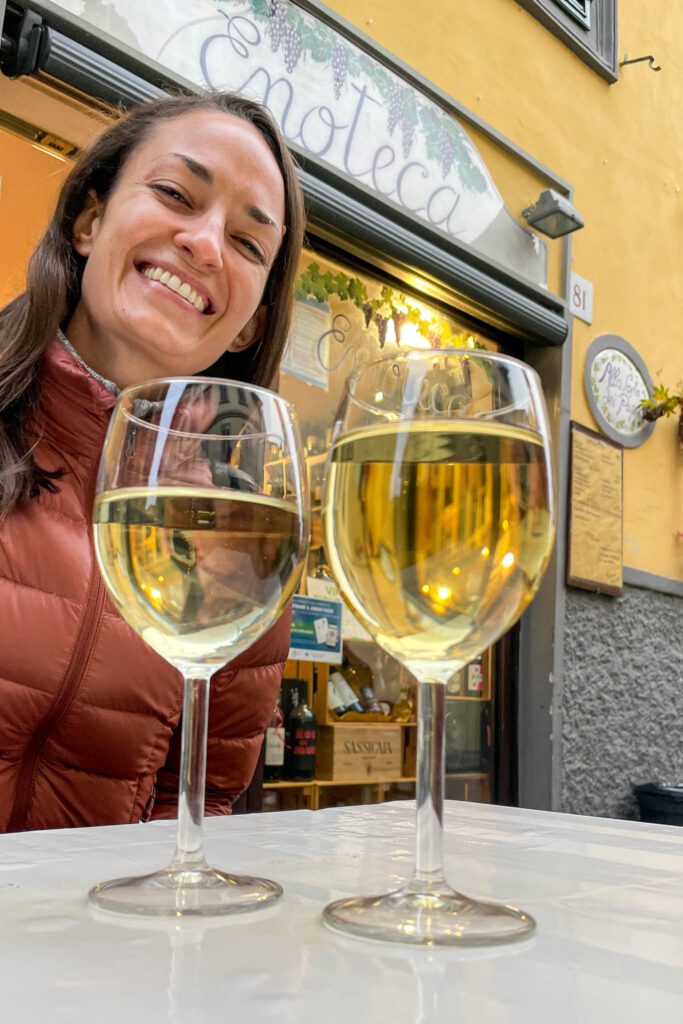
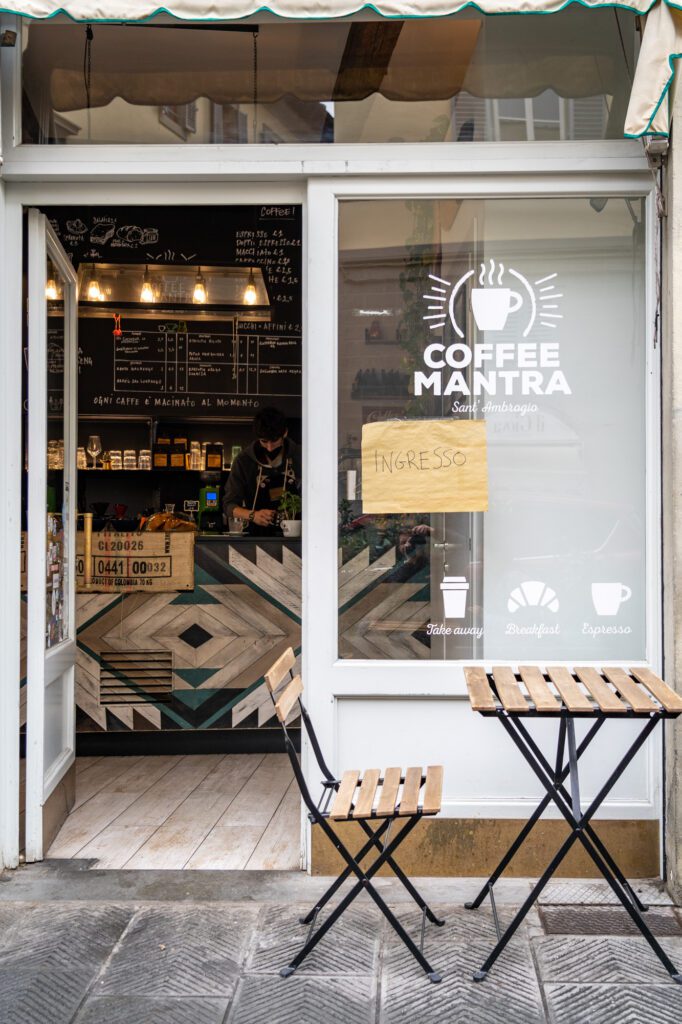
The Best Places to Stay in Santa Croce
There are a couple of places to stay in Santa Croce that we think you’ll like.
Pietrapiana Boutique Apartments (Where We’ve Stayed)
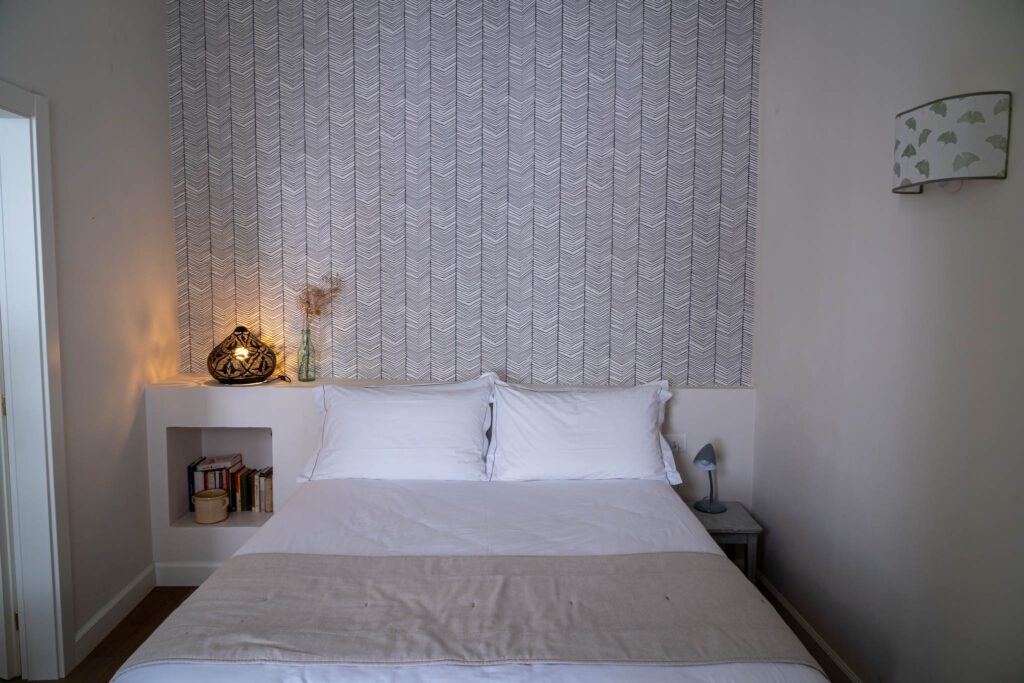
First of all, we stayed here, and highly recommend it for both the location and the apartments themselves.
We generally opt for apartments over hotels when we’re traveling because I have Celiac Disease and like to have access to a kitchen.
Pietrapiana was once an old family home in the Sant’Ambrogio district that has since been converted into 12 boutique apartments by a group of friends from Florence. All of the apartments are decorated in minimalist style with white walls and simple wood furnishings.
This would be a great place for groups and families to stay, because they have apartments with multiple beds that will make it so you can all stay together in the same unit, versus having to book separate hotel rooms (which, as you probably know, can get pricey).
They have options ranging from hotel-style rooms without kitchens to studios, one bedroom apartments, and two bedroom apartments that sleep up to five people.
The kitchen in our one bedroom unit was small, but plenty for what we needed with a fridge, sink, and two-burner stovetop with all the dishes and cookware you might need.
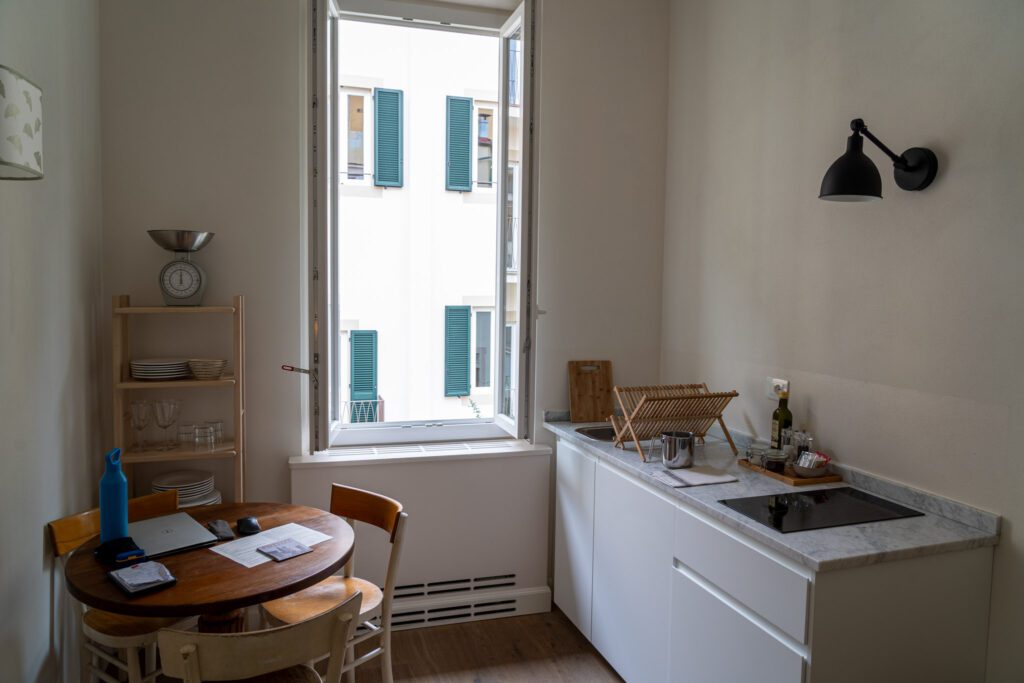
One of the benefits here is that you can leave your luggage before or after checking in or out, which is an amenity that most apartments don’t have.
We highly recommend it if you’re looking for a nice, comfortable apartment in a central location (that is also pretty quiet, because the units are set back from the street).
Dimora 72: A Great Value in Santa Croce
This small B&B – which is a couple of blocks north of the Basilica di Santa Croce – only has a few units (four), so book early if this is where you want to stay. The nature of having just four units means you’re also going to get more personalized service from the hosts (something that numerous reviews called out, which is why we mention it).
The units here have been recently renovated, and offer a range of room types from typical hotel-style rooms with double beds (worth noting that it’s a very spacious room compared to many you’ll find in Florence) to a suite with a full kitchen (there’s only one of these).
Clean, modern design elements are the name of the game here, with white walls and stylish bathrooms.
It’s an old building, but the units have air conditioning, which is crucial in the sweltering summer months in central Italy.
The location is great, the rooms are comfortable, and the staff is friendly and helpful. Not sure what else you could want in a home base for exploring the city!
The Centro Storico: The Best Location for First Timers
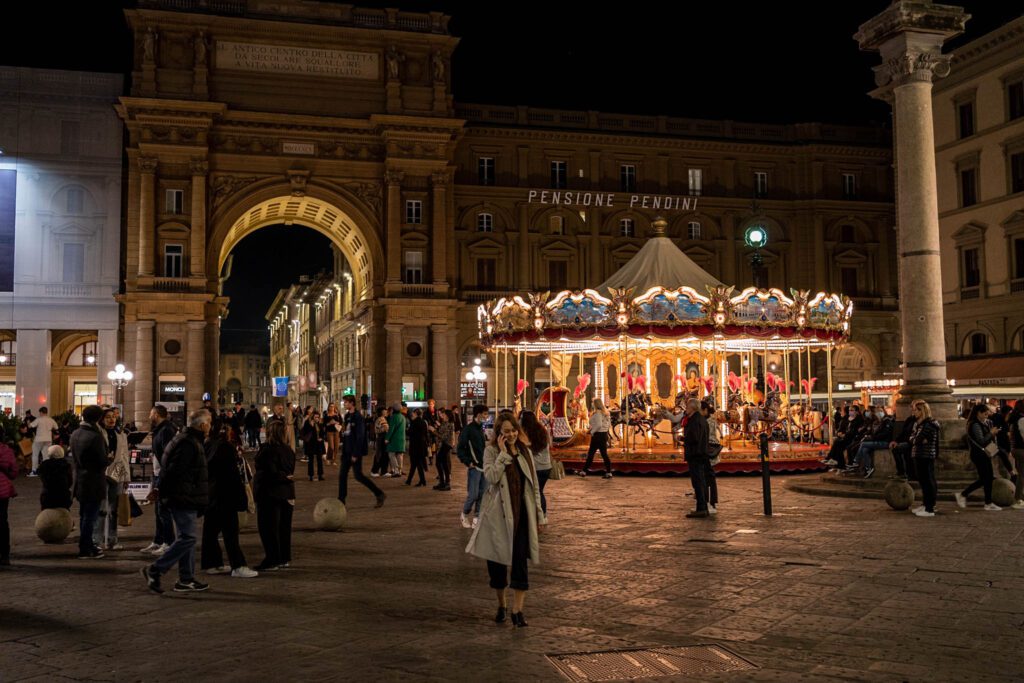
Florence’s historic center is the heart of the city, with the massive dome of Florence’s Duomo – Cattedrale di Santa Maria del Fiore – serving as the functional and architectural centerpoint.
For the purposes of this guide, we’re consolidating everything from San Lorenzo, which is at the northwestern edge of the neighborhood near the train station, down past the Duomo to the Arno River and Piazza della Signoria.
It’s a relatively big area with pockets that look and feel slightly different, but at the end of the day will all offer a relatively similar experience for visitors to Florence.
And that experience is one that certainly has pros and cons, which we’ll get to in a second, and might not be for everyone.
The main benefit of staying here is full immersion in the opulence of Florence. The architecture is gorgeous, and we still marvel at Brunneleschi’s Dome every time we lay eyes on it.
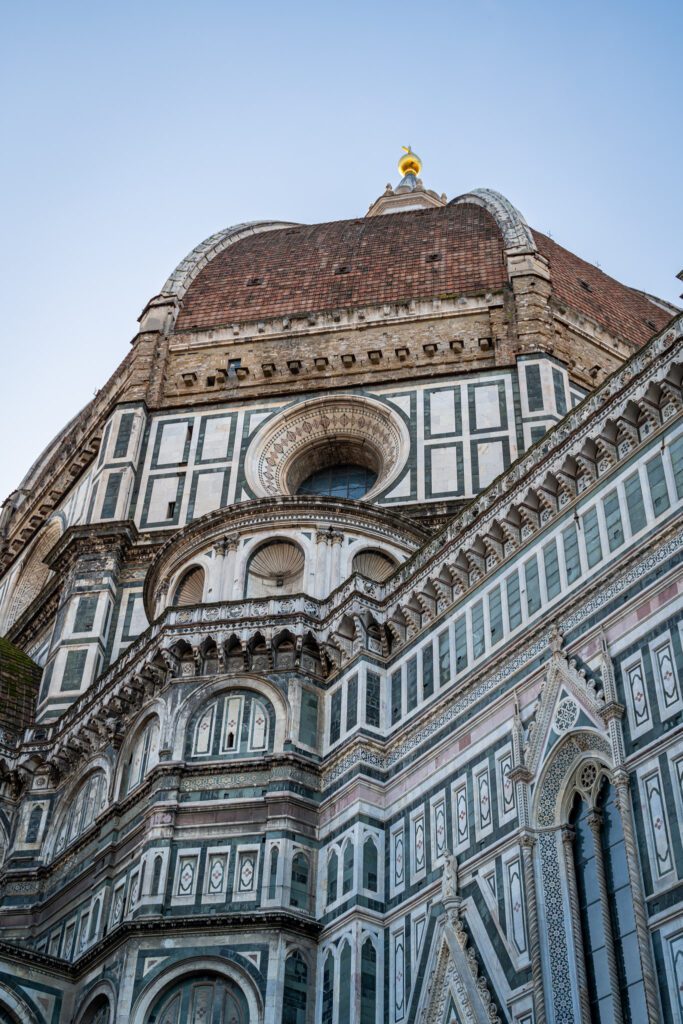
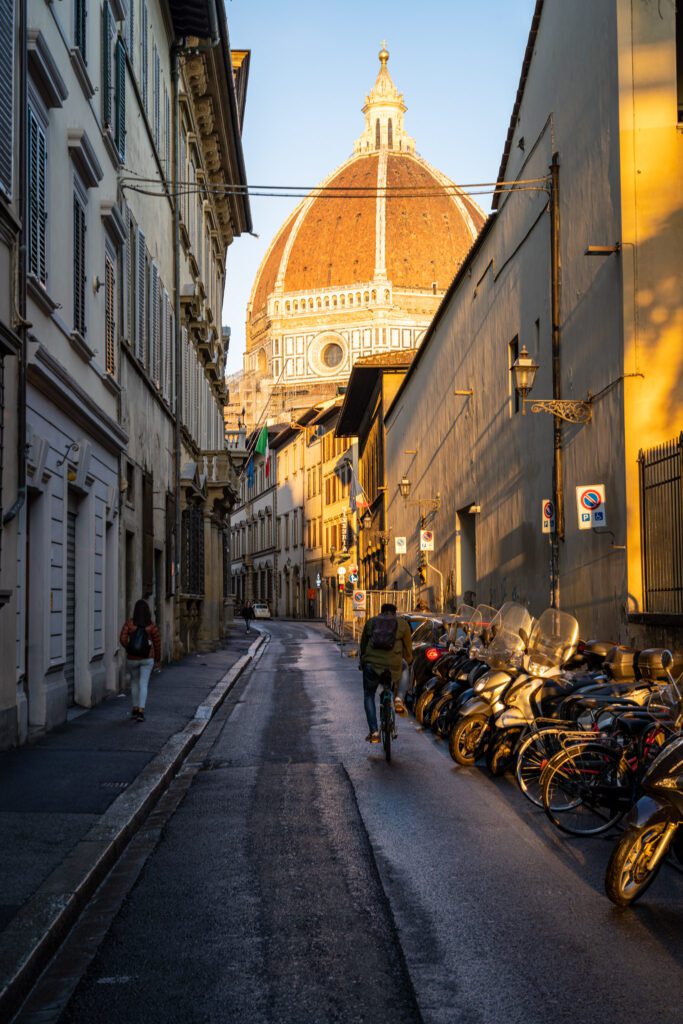
However, the use of the word “opulence” might tip you off to one of the trade offs of this area – it’s the most expensive part of Florence. Which makes sense, because it’s as central as it gets.
There are lots of choices when it comes to hotels here – including some with Duomo views – but you’re going to pay for it.
The other thing to know is that, while Florence and the rest of Tuscany offer a top tier food culture, featuring things like the famous Florentine steaks to wild boar ragu that my mom fell in love with on our Tuscany road trip for her 60th birthday.
However, the historic center is probably not the best place to experience that food culture (though there are some gems, like the highly recommended Trattoria Mario – go for lunch!), because many of the restaurants here have pictures on their menu (something to avoid at almost all costs) and are catered exclusively to tourists. Plan on doing your research and eating some of your meals elsewhere!
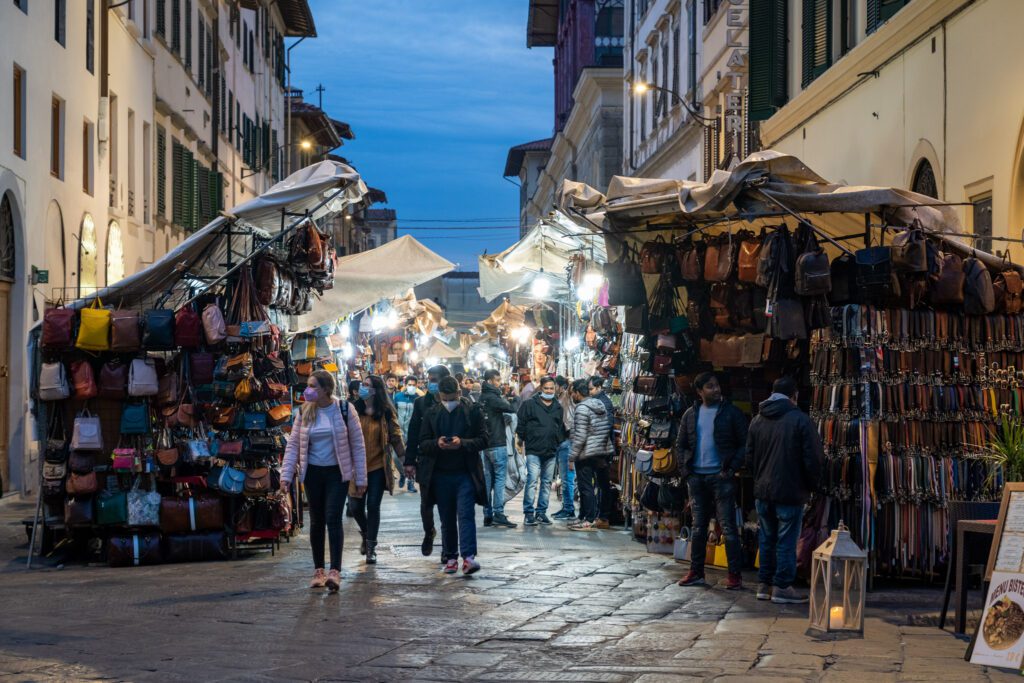
Pros and Cons of Staying in the Centro Storico
Here are the pros and cons of staying in the heart of Florence’s Centro Storico as we see them.
Pros of Staying in the Centro Storico
- Close to all the attractions. No matter where you stay in the Centro Storico, you’re guaranteed to be just a few minutes walk to all of the city’s main sites.
- Tons of hotels to choose from. It’s not surprising, but this part of the city has the largest concentration of hotels of any neighborhood, which means a nice range of hotels to choose from (though, as we’ll get to, they do skew slightly pricier than elsewhere in the city).
Cons of Staying in the Centro Storico
- Lots of tourists. Staying in the heart of Florence’s Centro Storico does mean you’ll likely be surrounded by other tourists most of the time. This isn’t necessarily a bad thing if you don’t mind the crowds and are not looking for a more ‘local’ experience (to the extent that that even exists for travelers in Florence).
- Higher prices. Due to the high demand in this area, it can be one of the more expensive places to stay in Florence. There are a lot of options, but not as many on the budget side of the spectrum as we’d like.
- No parking. If you’re visiting Florence as part of an Italian road trip, it’s important to remember that the city’s historic center is a limited traffic zone (ZTL) so you won’t be able to drive or park here.
Centro Storico Highlights
Here are some of our favorite places in the historic center, in no particular order.
- Piazza del Duomo is where you’ll find many of Florence’s most iconic landmarks, including the grand Gothic-Renaissance Duomo and Brunelleschi’s Dome, the Baptistery and Giotto’s Campanile. Climbing the dome is a must, and we particularly love the view from the interior of the dome, where you can see the beautiful art up close (versus from hundreds of feet below if you just enter the church).
- Piazza della Signoria is the city’s main square and a free open-air gallery, filled with numerous important statues and sculptures (including a replica of the David).
- The Uffizi Gallery is a world-famous art gallery and one of the city’s most famous attractions. Home to an unparalleled collection of Renaissance and European art, the gallery is a must-visit in the city known as the ‘Birthplace of the Renaissance’. We did this guided tour, and absolutely loved it.
- Ponte Vecchio, which crosses over the Arno River, is the oldest bridge in Florence and was the only one to survive the bombings of World War 2. The unusual bridge has been lined with shops since the 13th century.
- Ciro and Sons Pizza is Florence’s first gluten free pizzeria that serves delicious Neapolitan style pizzas that are both gluten free and lactose free. One of the best places to eat in Florence for Celiacs (though you should read our guide to the best gluten free restaurants in Florence for a couple of other options).
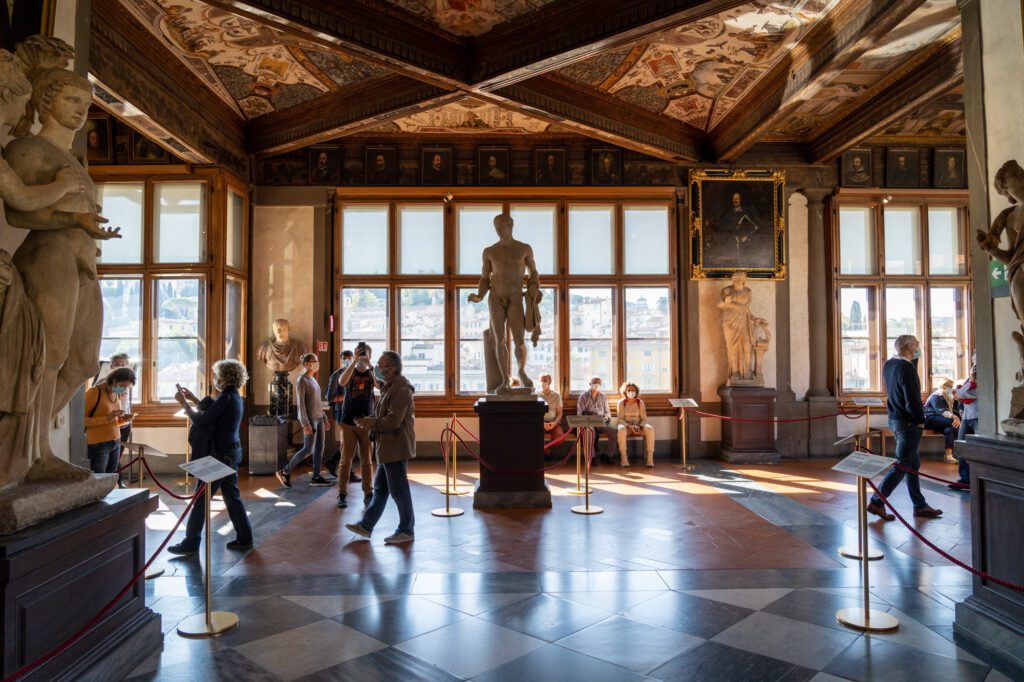
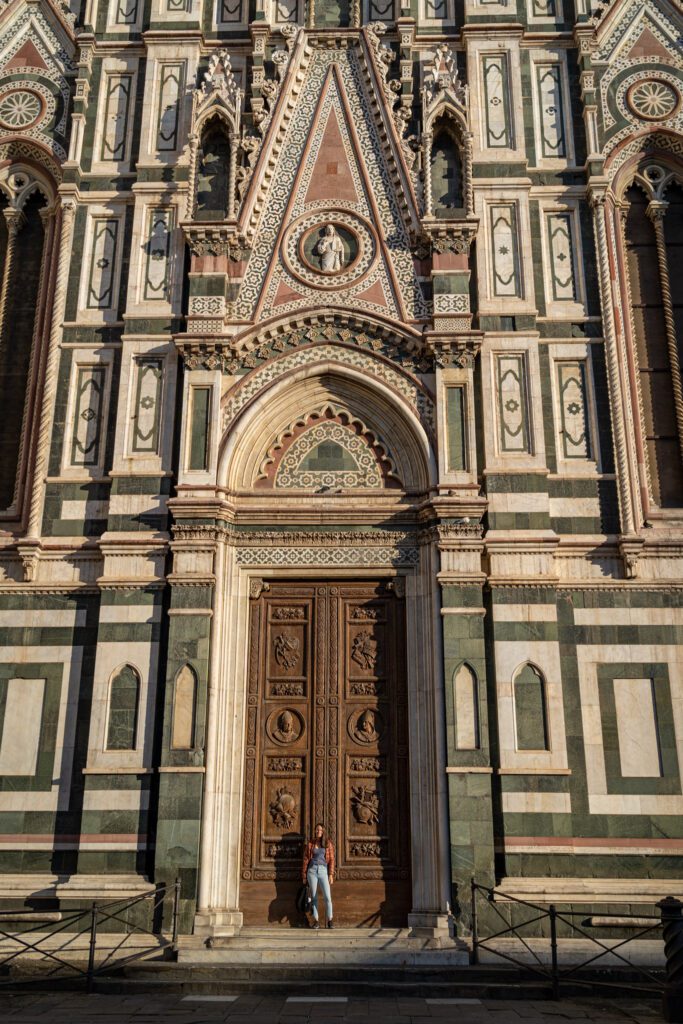
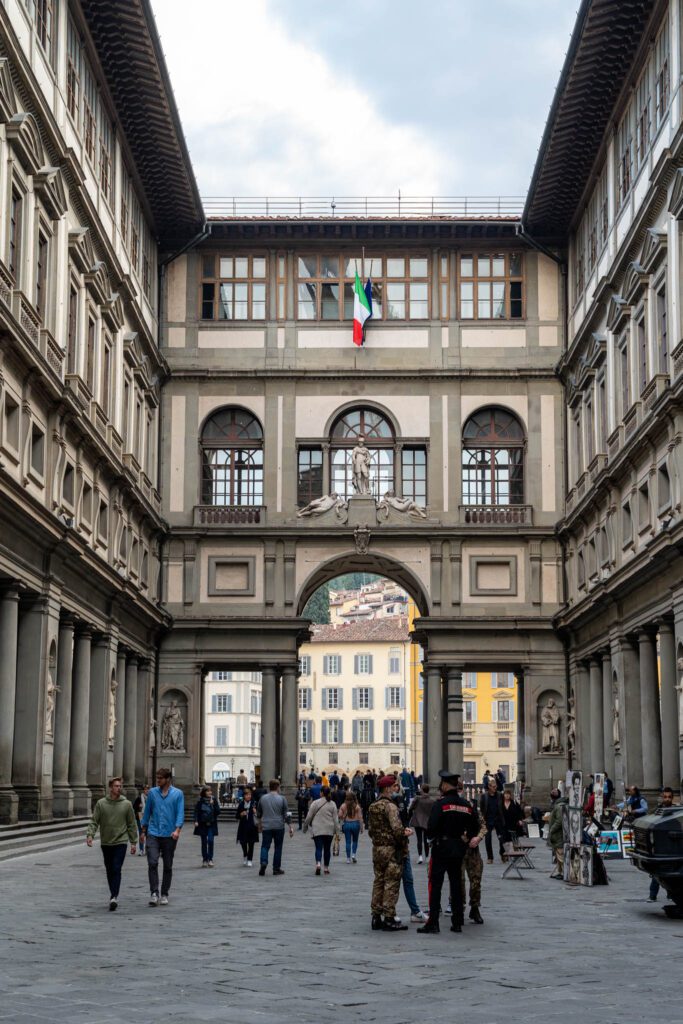
The Best Places to Stay in the Centro Storico
There are a couple of places to stay in Florence’s historic center that we think you’ll like.
Relais Piazza Signoria: Apartments Right on Piazza Della Signoria
As the name suggests, Relais Piazza Signoria is located in a renovated historic building right on Piazza Signoria, one of the most important squares in Florence (where you’ll find Palazzo Vecchio, the replica statue of David, and the statue of Cosimo I de’ Medici, who shaped the city as you see it today).
From here, you can reach the Uffizi Gallery and Duomo (not to mention Ponte Vecchio and Oltrarno) in mere minutes. You really can’t get any more centrally located than this.
Rooms range from studio apartments with unbeatable views across the piazza to a stunning and spacious penthouse with its own private terrace.
Each room also comes with its own fully equipped kitchenette, which we value because we often like to cook for ourselves (especially breakfast) to save money when we’re on the road.
The Artists’ Palace Florence: A Great Value in a Convenient Location
This recently renovated boutique hotel is right on Piazza di San Lorenzo, and many of the rooms have views of the stone facade of the Basilica di San Lorenzo.
The location here is pretty nice because, on the one hand, it’s the closest part of the historic center to the train station (7-10 minutes on foot), which means a relatively easy journey on arrival and departure.
On the other hand, it’s also just one long block from the Duomo (and the area around San Lorenzo is actually a great place to eat, despite its location smack dab in the middle of a tourist-centric area).
The building itself dates back to the 1500s, though it has been beautifully renovated on the inside to bring it into the 21st Century, with modern, minimalist design, lots of natural light, and carefully thought-out amenities like air conditioning (a necessity if you’re visiting Florence during the summer).
Rooms range in size and layout from classic hotel-style rooms to family rooms (multiple beds in a larger space) and deluxe family rooms (two connected rooms).
Oltrarno: A More Residential Option Across the River
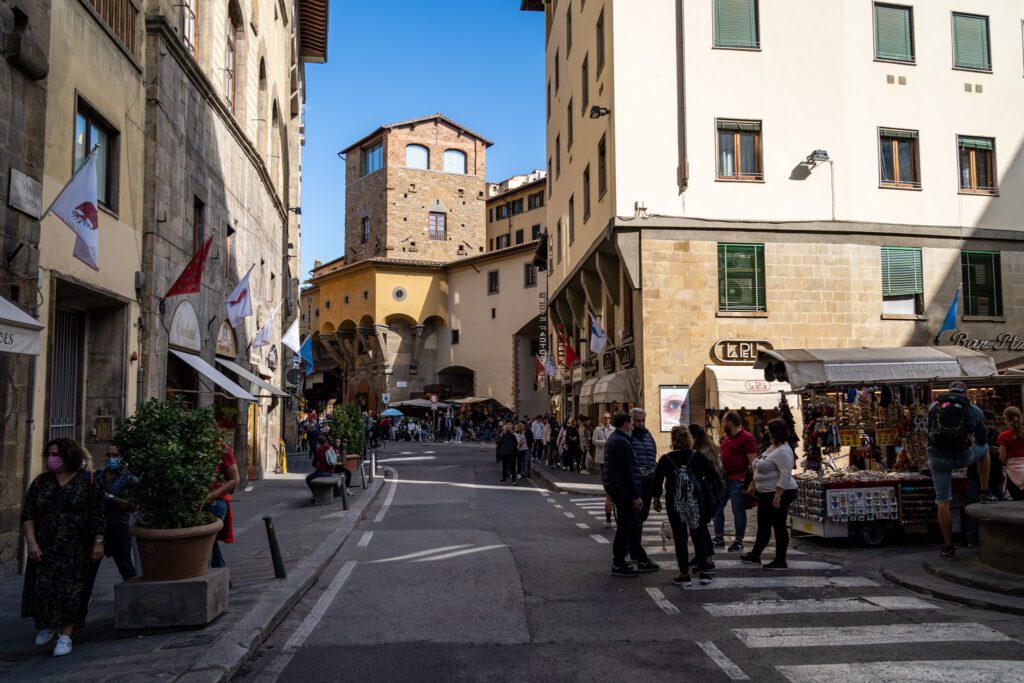
If you asked us to pack up and move to Florence tomorrow and choose a neighborhood from the ones in this guide to live in, we’d choose Oltrarno. The name roughly translates to “across the Arno,” and it sits on the south side of the river, opposite from the historic center (though, crucially, just a short walk away).
However, it’s almost always the case that the neighborhoods we’d want to live in are the ones that don’t have as many options in terms of accommodations for tourists, which is certainly the case here (and is part of the reason why it stands out to us).
The energy around Piazza Santo Spirito in the evening is reminiscent of parts of Rome’s Trastevere, which is our favorite place to stay in Rome. People sitting around the piazza, either at one of the terraces or on the benches around the fountain, and just being with each other.
The buzz of animated conversation can be heard from blocks in any direction at times (mostly weekend evenings), and we appreciate the energy, which is something you don’t get all that often at home (do we even have shared public spaces anymore?).
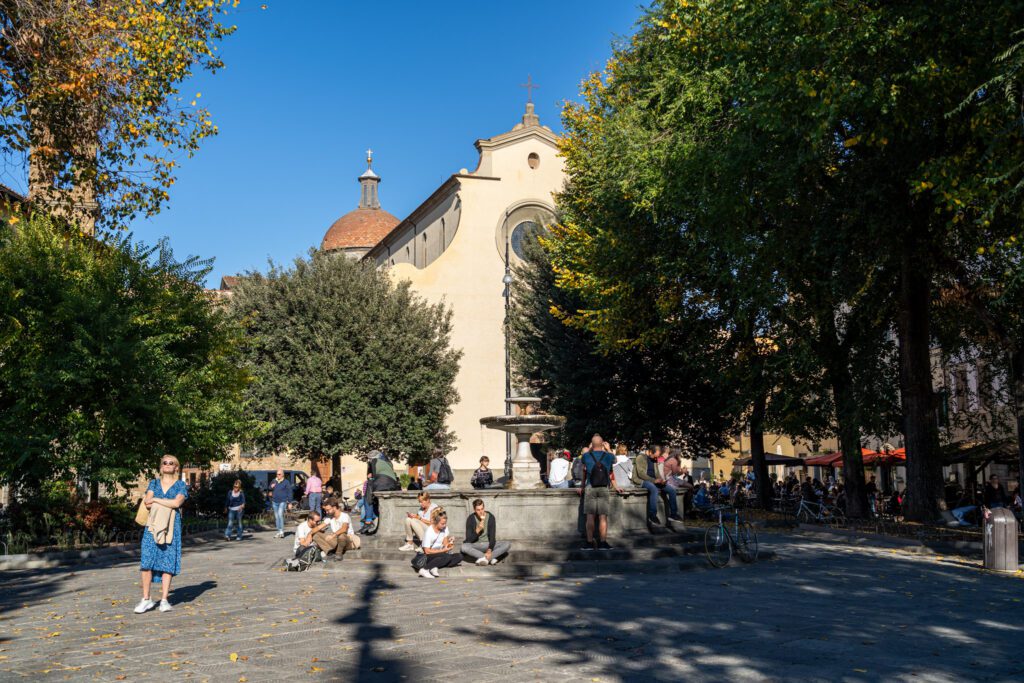
Aside from that single piazza, there are plenty of other things to do, see, eat, and drink in Oltrarno that make it worth your time, including our personal favorite gelato shops and wine bars in the city.
The other thing we like about this part of the city is the green spaces, which is something we’re spoiled with at home in Portland (and is a big reason why we’ve fallen in love with our adopted home city).
Between the Boboli Gardens and the small-but-mighty Giardino Bardini (which you should walk through on your way up to Piazzale Michelangelo, the best view in Florence), there are a plethora of green spaces to enjoy (which can’t be said for the other side of the river, where it’s all concrete or stone all the time for the most part).
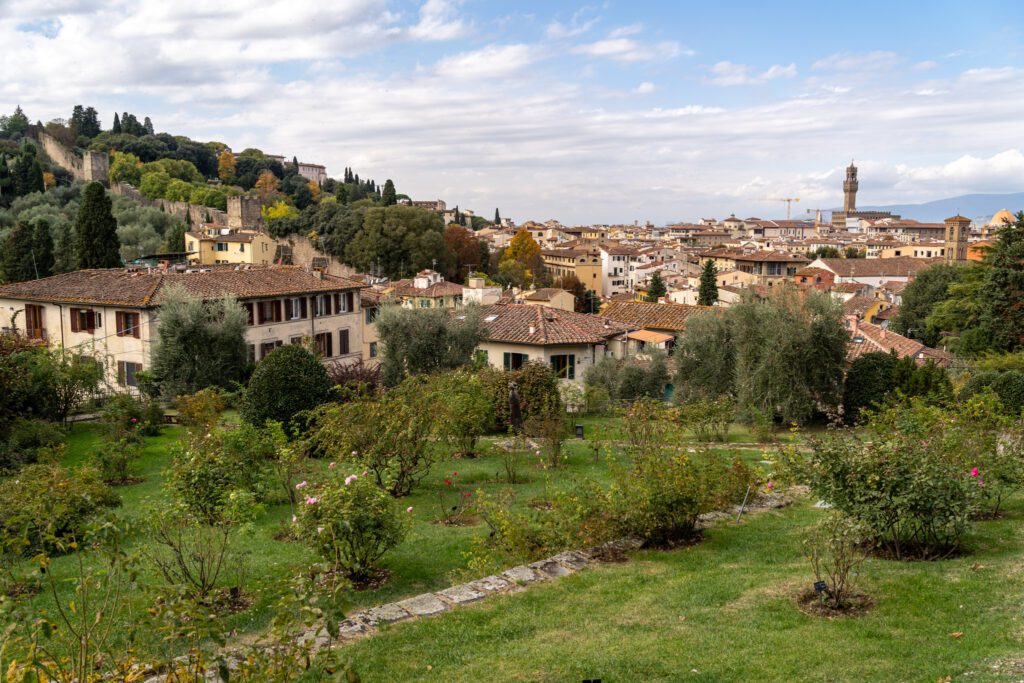
Pros and Cons of Staying in Oltrarno
Here are the pros and cons of staying in Oltrarno as we see them.
Pros of Staying in Oltrarno
- It’s less crowded. The big tourist crowds of the city center tend not to make it down to Oltrano, making it better for quiet stays.
- Great nightlife. The piazzas of Santo Spirito and San Frediano are packed with cool bars which are popular with the city’s young local crowd.
- Parking. Some parts of Oltrarno are outside of the ZTL so it’s a convenient place to stay if you’re traveling by car.
Cons of Staying in Oltrarno
- Not many places to stay. The biggest problem with Oltrarno as a home base is that there just aren’t that many places to stay here.
- Distance from main attractions. Parts of Oltrano are a little further away from the city’s main attractions north of the river so you’ll either need to walk further or make the most of Florence’s fleet of small electric ATAF buses.
Oltrarno Highlights
Here are some of our favorite places in Oltrarno, in no particular order.
- Piazza Santo Spirito is the main square in Oltrarno and is filled with plenty of shops, restaurants, and bars. Being the primary hub of activity in the area, you’ll often find markets and special events taking place in the piazza too.
- Pitti Palace is a series of museums and galleries housed inside a grand 15th-century Renaissance palace. Exploring the numerous fascinating galleries is a great way to spend a rainy day in Florence.
- Boboli Gardens are vast and elegant gardens filled with fountains, pergolas, grottos, and hundreds of ornate Renaissance statues. The perfect place to escape the busy streets of Florence for a while.
- Basilica di Santo Spirito may not be as striking from the outside as other churches in Florence, but inside, Santo Spirito – which was designed by Brunelleschi – is home to a vast collection of important religious artwork.
- Palazzo of Bianca Cappello is a Renaissance-style palace with a beautiful façade, known as the setting for one of Florence’s most famous love stories between Francesco I de’ Medici and his mistress-turned wife Bianca Cappello.
- Ditta Artigianale is our favorite place to stop for coffee in Oltrarno, and right next door is Gelateria della Passera, Alysha’s favorite gelato shop in Florence.
- La Casalinga is one of the best restaurants in the area for traditional Florentine cuisine, and it’s right on Piazza Santo Spirito.
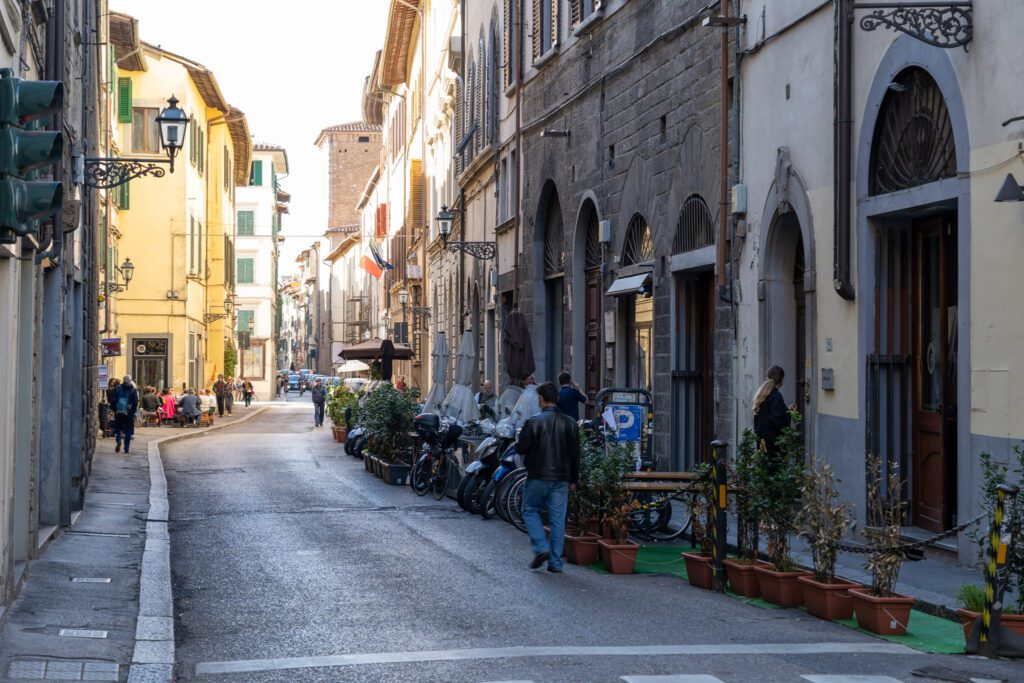
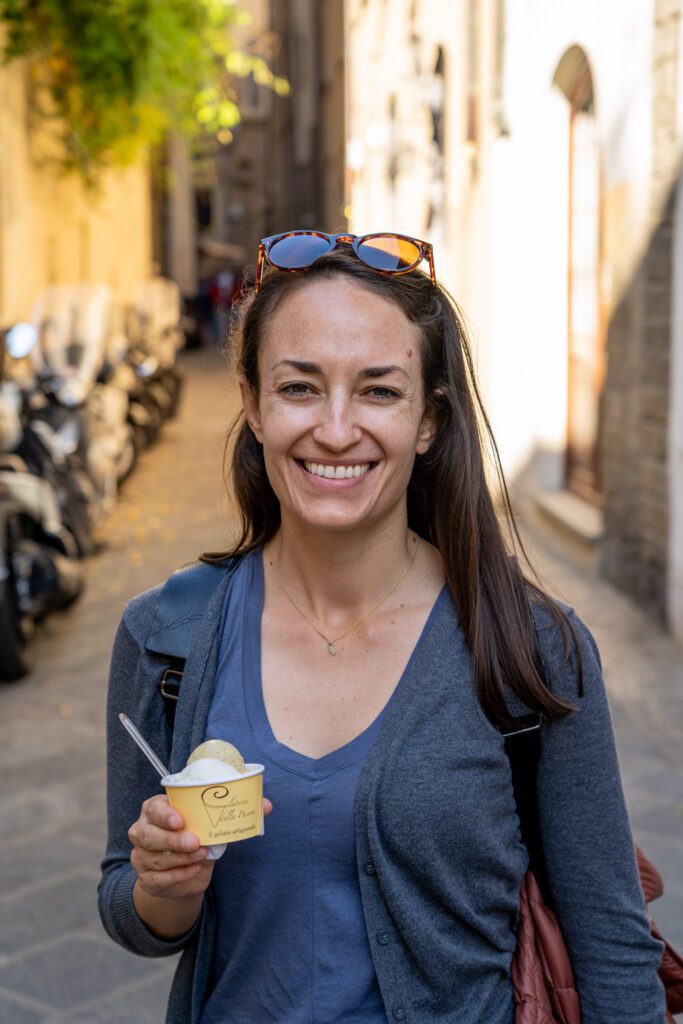
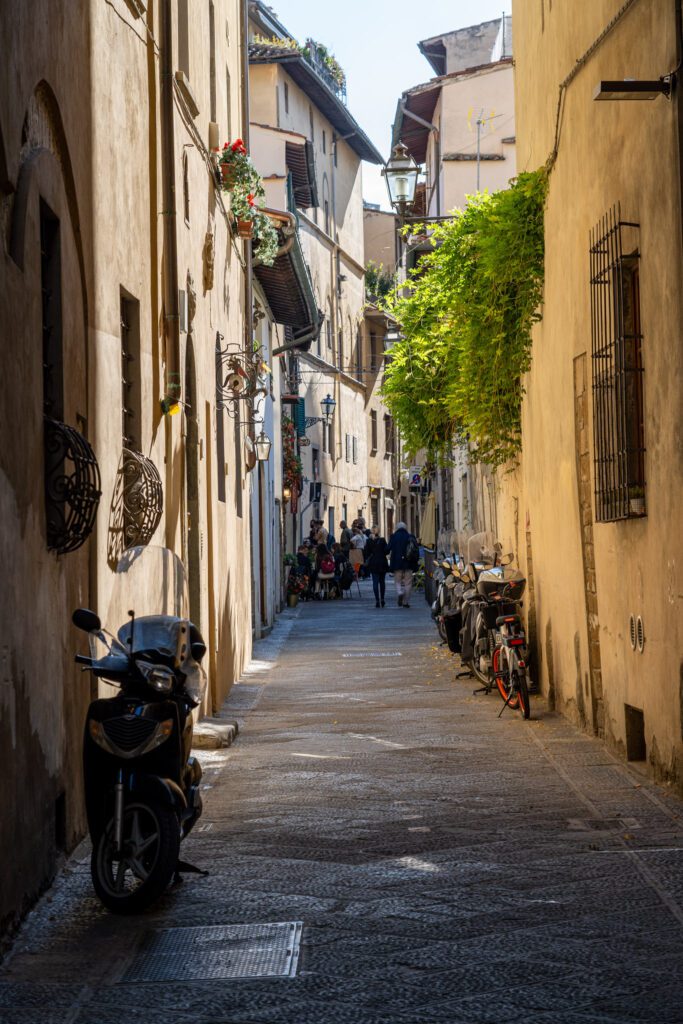
The Best Places to Stay in Oltrarno
There are a couple of places to stay in Oltrarno that we think you’ll like.
FuordArno Bed & Breakfast: A Charming B&B on the Arno River
We do love a good bed and breakfast – and that does mean that both the bed and the breakfast have to be included. This charming B&B is just up the road from the main stretch in Oltrarno, and is a slightly more budget-friendly option on the eastern end of the neighborhood, close to Porta San Niccolò.
It’s located in an old family home and has just five rooms to choose from, sleeping between two and four people. Which means it’s a relatively small place, so book early!
Each room is named after a different city/place around the world and is beautifully decorated to match the city’s vibe, such as the colorful Bali room with a curtained four poster bed, or the chic Copenhagen room with a simple Nordic aesthetic.
There’s also a cozy lounge for guests to use, with a TV, games, magazines, and books, as well as a communal kitchen where a complimentary breakfast is prepared each morning.
San Marco: The Best Value in Florence (+ It’s Quieter!)
If you’re looking for a more affordable place to stay that is walkable to the historic center but doesn’t have as much going on as the other neighborhoods in this guide, San Marco is probably a good bet.
Staying here means paying 10-20% less for a room, but adding a 10-15 minute walk to your journey to most of Florence’s main sights (with the notable exception of the Galleria dell’Accademia di Firenze).
The other benefit of staying here is that, because there’s not much to do or see here in terms of traditional tourist attractions, it’s going to be significantly quieter and less crowded than the other parts of Florence you’re going to venture out into. An oasis of relative calm in a city that is nearly pure chaos during peak season.
If you value a good night’s sleep (we do!), you’ll be more likely to get it here than in, say, Santa Croce, where the nightlife extends into the early morning hours on Fridays and Saturdays.
Overall, San Marco is a good option if you’re on a budget and don’t mind a little extra travel time to get from place to place, but the neighborhood itself doesn’t offer much in terms of attractions.
Pros and Cons of Staying in San Marco
Here are the pros and cons of staying in San Marco as we see them.
Pros of Staying in San Marco
- It’s more affordable. The combination of a plethora of hotels and being a bit outside of the traditional tourist areas means that the prices are going to be a bit more affordable in this part of Florence.
- It’s relatively walkable to the center. From most of our hotel suggestions below, it’s a 10-15 minute walk to the Duomo (further to cross the river into Oltrarno or over to Santa Croce).
- Lots of hotels to choose from. There are plenty of hotel options here with a range of budget-friendly options, which can’t be said for the more central parts of the city. Most of the hotels here are further north near Piazza della Libertà, which has tradeoffs – it’s further from the center, but closer to the bus lines that circumnavigate the historic center to take you to Sant’Ambrogio, Piazzale Michelangelo, and Oltrarno (it takes ~30 minutes, but it’s faster than walking).
- It’s quieter. The lack of traditional tourist attractions in the main part of the neighborhood and the relative distance from the center means it’s not the nightlife hub that Santa Croce is. It’ll be a bit quieter and more low-key than staying more central.
Cons of Staying in San Marco
- The neighborhood itself is a little dull. Especially the further north and west you go, away from the center and the University. But that’s not a huge issue because you’re close enough to the other more exciting parts of the city.
- It’s far from Oltrarno and the other side of the river. Places like Pitti Palace, Piazzale Michelangelo, and the Boboli Gardens are a ~40 minute walk from San Marco, but you can utilize the bus lines that run from the northern border of the neighborhood to cut down that travel time.
Santa Maria Novella: A Convenient Area for Short Stays and Day Trips
Generally speaking, the area immediately around a train station in any European city that sees a lot of tourists – which Florence certainly qualifies for – is not going to be the most charming part of the city.
However, in cities like Madrid, Milan, and Barcelona (and, spoiler alert, Florence!) where there are a lot of great day trips nearby, it can be convenient to stay near the train station to avoid trekking across the city to catch your train to whatever day trips you’re heading out to.
Alternatively, if you only have one day in Florence on your broader trip to Italy, staying near the train station can be a good way to maximize your time actually exploring (rather than being in transit to and from the train station).
The area around Florence is home to a wealth of great day trip destinations – Bologna, Lucca, and Siena (to name a few, we have a whole guide dedicated to great day trips from Florence) – and they are all a short train ride away from Florence’s main train station, Santa Maria Novella.
For the purposes of this particular guide, we’re talking about the area within several blocks of the train station in either direction, but PARTICULARLY the area to the southwest between the eponymous basilica (the Basilica of Santa Maria Novella) and the Arno River.
Technically, the neighborhood extends far to the west along the river, but to maximize the benefit of being near the train station, we’d stay closer in (look at hotels east of Viale Fratelli Rosselli).
This is the part of the neighborhood where you’ll get the best balance of centrality (a 5-10 minute walk to the train station) and hotel choice.
It’s not the sexiest neighborhood in Florence, and it is a bit further from Florence’s main historic center than some of the other neighborhoods we’ve covered, but it would make a convenient home base for a short stay or if you’re using Florence as a home base to do multiple day trips.
Pros and Cons of Staying in Santa Maria Novella
Here are the pros and cons of staying in Santa Maria Novella as we see them.
Pros of Staying in Santa Maria Novella
- It’s near the train station. Perfect for day trips! We recommend using Florence as a base to do day trips in all of our Italy itineraries (here’s our 10 day Italy itinerary, for reference), and staying near the train station will make this about as easy as it gets.
- Lots of hotel choices. This neighborhood has tons of hotel options to choose from, particularly in the area we recommend southwest of the train station close to the river.
- Budget-friendly options. Since it’s not the most desirable neighborhood in Florence AND there are a lot of hotel options, there’s a nice range of budgets represented here. Generally speaking, the same room is going to be 10-20% cheaper here than in the historic center (if not more).
Cons of Staying in Santa Maria Novella
- The food and drink options are elsewhere. With few exceptions, you’re going to want to plan on eating your meals elsewhere. The biggest exception is Fuoco Matto, which is on the border with San Marco and was recommended to me by a local (though I can’t eat there because they don’t have safe gluten free options).
- It’s far from places like Santa Croce and Oltrarno. While it’s relatively close to the historic center (10-15 minute walk), it’s further from Santa Croce, Sant’Ambrogio, and Oltrarno. And the bus options aren’t great in Florence, so it’s not like you can easily cut down that travel time.
Planning a trip to Italy? We’d love to help!
Here are our other Italy travel guides to help you plan an incredible trip (even if you have to eat gluten free!).
If there’s no link below, it means we’re still working on it – long, in-depth guides take time! We’re working on it, though, we promise.
If you’re planning a trip and you’re not sure where to start, your first stop should probably be one of our detailed itineraries.
We have a two week Italy itinerary that blends the main cities with some less-visited cities that we love (BOLOGNA!), a guide to spending 10 days in Italy that focuses mostly on the highlights, and a whirlwind guide to spending one week in Italy that features the Rome – Florence – Venice highlight circuit.
Here are more specific guides to the main cities in Italy.
Rome
- What to do in Rome (as a First Timer)
- How to Plan an Amazing 4 Day Rome Itinerary
- Where to Stay in Rome: A Complete Guide for First Timers
- 12 Things to Know Before You Visit Rome
- Gluten Free Rome: A Complete Guide to GF Restaurants + Bakeries
- Where to Find the Best Specialty Coffee in Rome
Florence
- What to do in Florence (as a First Timer)
- How to Plan an Amazing Florence Itinerary (3 Days)
- Where to Stay in Florence: A Complete Guide for First Timers
- Gluten Free Florence: A Complete Guide to GF Restaurants + Bakeries
- Where to Find the Best Specialty Coffee in Florence (for Coffee Nerds)
- The Best Day Trips from Florence (Complete Planning Guide)
Bologna
- What to do in Bologna (as a First Timer)
- How to Spend One Incredible Day in Bologna
- How to Plan an Amazing Bologna Itinerary (2 Days)
- Where to Stay in Bologna: A Complete Guide for First Timers
Cinque Terre
- What to do in Cinque Terre (as a First Timer)
- How to Plan an Amazing Cinque Terre Itinerary (2 Days)
- Where to Stay in Cinque Terre: A Complete Guide for First Timers
Milan
- What to do in Milan (as a First Timer)
- How to Plan an Amazing Milan Itinerary (2 Days)
- Where to Stay in Milan: A Complete Guide for First Timers
- Gluten Free Milan: A Complete Guide to GF Restaurants + Bakeries
- Where to Find the Best Specialty Coffee in Milan (for Coffee Nerds)
The Rest of Italy
